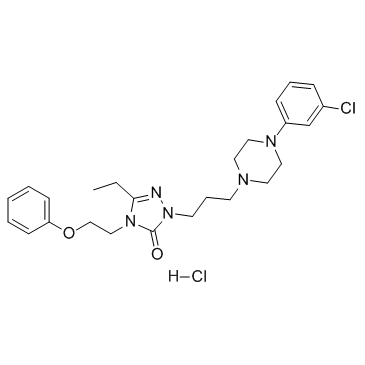Comparison of the bioactivation potential of the antidepressant and hepatotoxin nefazodone with aripiprazole, a structural analog and marketed drug.
Jonathan N Bauman, Kosea S Frederick, Aarti Sawant, Robert L Walsky, Loretta M Cox, Ronald S Obach, Amit S Kalgutkar
文献索引:Drug Metab. Dispos. 36(6) , 1016-29, (2008)
全文:HTML全文
摘要
In vitro metabolism/bioactivation of structurally related central nervous system agents nefazodone (hepatotoxin) and aripiprazole (nonhepatotoxin) were undertaken in human liver microsomes in an attempt to understand the differences in toxicological profile. NADPH-supplemented microsomal incubations of nefazodone and glutathione generated conjugates derived from addition of thiol to quinonoid intermediates. Inclusion of cyanide afforded cyano conjugates to iminium ions derived from alpha-carbon oxidation of the piperazine ring in nefazodone and downstream metabolites. Although the arylpiperazine motif in aripiprazole did not succumb to bioactivation, the dihydroquinolinone group was bioactivated via an intermediate monohydroxy metabolite to a reactive species, which was trapped by glutathione. Studies with synthetic dehydroaripiprazole metabolite revealed an analogous glutathione conjugate with molecular weight 2 Da lower. Based on the proposed structure of the glutathione conjugate(s), a bioactivation sequence involving aromatic ortho-or para-hydroxylation on the quinolinone followed by oxidation to a quinone-imine was proposed. P4503A4 inactivation studies in microsomes indicated that, unlike nefazodone, aripiprazole was not a time- and concentration-dependent inactivator of the enzyme. Overall, these studies reinforce the notion that not all drugs that are bioactivated in vitro elicit a toxicological response in vivo. A likely explanation for the markedly improved safety profile of aripiprazole (versus nefazodone) despite the accompanying bioactivation liability is the vastly improved pharmacokinetics (enhanced oral bioavailability, longer elimination half-life) due to reduced P4503A4-mediated metabolism/bioactivation, which result in a lower daily dose (5-20 mg/day) compared with nefazodone (200-400 mg/day). This attribute probably reduces the total body burden to reactive metabolite exposure and may not exceed a threshold needed for toxicity.
相关化合物
| 结构式 | 名称/CAS号 | 分子式 | 全部文献 |
|---|---|---|---|
 |
奈法唑酮盐酸盐
CAS:82752-99-6 |
C25H33Cl2N5O2 |
|
Systematic evaluation of commercially available ultra-high p...
2014-12-29 [J. Chromatogr. A. 1374 , 122-33, (2014)] |
|
The relation between changes in patients' interpersonal impa...
2012-06-01 [J. Consult. Clin. Psychol. 80(3) , 354-64, (2012)] |
|
Inhibition of G protein-activated inwardly rectifying K+ cha...
2011-01-01 [PLoS ONE 6(12) , e28208, (2011)] |
|
Dyadic discord at baseline is associated with lack of remiss...
2010-03-01 [Psychol. Med. 40(3) , 415-24, (2010)] |
|
The Psychopharmacology Algorithm Project at the Harvard Sout...
2011-01-01 [Harv. Rev. Psychiatry 19(5) , 240-58, (2011)] |